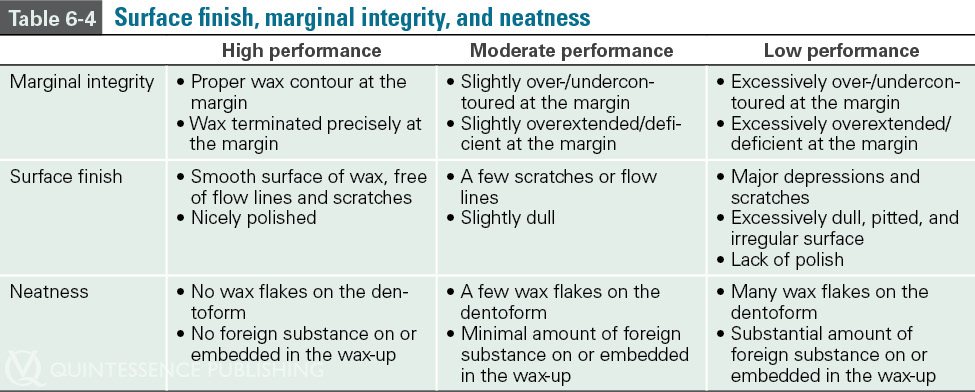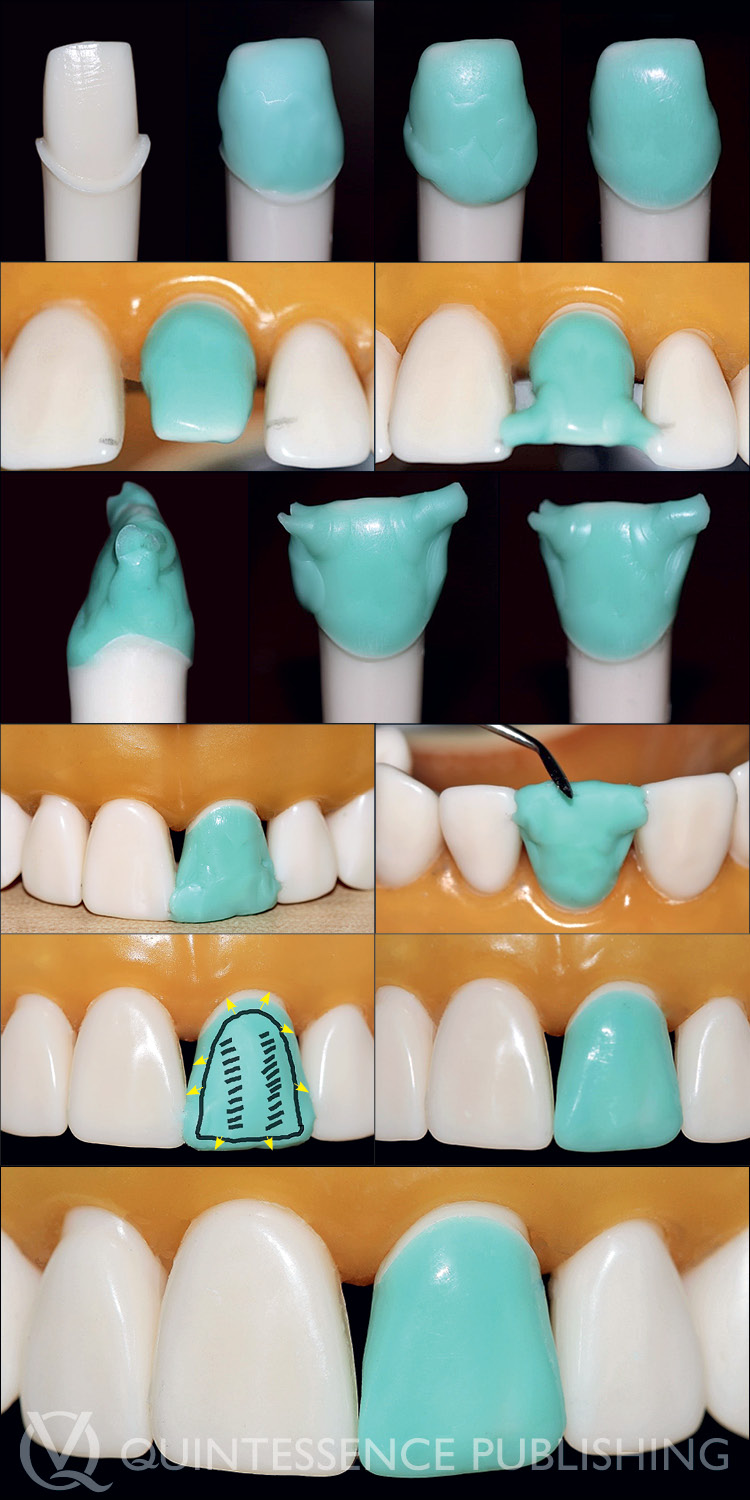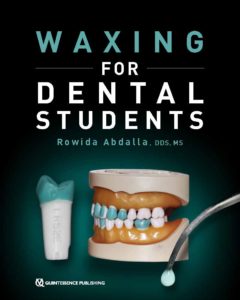When dental students are first taught how to wax teeth, they need clear instructions with logical steps and plenty of illustrations. When Rowida Abdalla, DDS, MS, set out to find such a resource to use in the waxing course she teaches at the University of Kentucky College of Dentistry, she found the literature was coming up short. But teachers and dentists aren’t really the types to just give up if an answer doesn’t exist, and Dr Abdalla is both—so, she created the waxing manual her students needed: Waxing for Dental Students (Quintesesnce, 2018).
Filling the Gap
“Students learn how to wax teeth during their first year of dental school,” Dr Abdalla explains. “The purpose of this is to teach them the morphology of the teeth and to develop their hand skills. Waxing is quite challenging in the beginning and requires a lot of practice, and struggling with waxing is a common complaint for first-year dental students. I did an extensive search to find a helpful resource for my students, but none of the waxing manuals available were suitable for first-year dental students. First, there are very few waxing books available period, and what books are available are written for laboratory technicians, not dental students.”
The main difference between waxing manuals for lab technicians and the resource Dr Abdalla created is that the former texts focus mostly on waxing crowns and bridges on dies in occlusion. But waxing into occlusion can be far too advanced for students who are still developing their mechanical skills.
“Although there are similarities between waxing dentoform teeth and waxing dies, there are many differences in the steps when occlusion is not considered,” Dr Abdalla emphasizes. “Waxing a die requires skills and knowledge that first-year dental students are still developing, and texts that include information that they haven’t learned yet, such as trimming dies, crowns, and bridges, can be distracting. The main purpose of the waxing course for first-year dental students is not to create a perfect prosthetic restoration, but rather to teach them the anatomy of each individual tooth so that they will eventually be able to restore teeth to the correct form and duplicate the correct tooth contours. Equally important is the opportunity waxing gives students to familiarize themselves with hand instrumentation techniques. Skills such as finger dexterity, hand steadiness, aiming, and reaction time are essential for the high level of precision necessary in dentistry and are developed during the first-year waxing course. The lessons and steps in the book are presented in a sequence that enables students to develop these skills cumulatively.”

Illustrations from Dr Abdalla’s book showing how to hold waxing instruments when waxing inside and outside the dentoform.

Labial and lingual views of a maxillary central incisor with morphological landmarks labeled.
A Comprehensive Resource for Both Students and Educators
It is clear that Dr Abdalla drew on her teaching experience for every decision made while writing and developing this book. The result is a resource explicitly designed to meet the needs of both educators and students—a resource that’s easy to teach from and easy to learn from.
“I’ve been teaching the waxing course at the University of Kentucky for 3 years,” Dr Abdalla explains, “and in that time I’ve noticed the importance of introductory exercises (partial-crown wax-ups) before moving to full crowns. Partial wax-ups allow the students to focus on the details of the tooth anatomy without needing the high skill involved in building the entire tooth from scratch. I’ve also learned that one or two of these introductory exercises are usually sufficient before moving to full-crown wax-ups, and that additional exercises only take up time without adding much benefit for the student.”
Dr Abdalla has also included evaluation criteria and grading rubrics for the instructor to make her book a more comprehensive course manual.

An example of one of the grading rubrics in chapter 6 of the book.
“The evaluation criteria and grading rubrics are provided so that dental educators who use this book for their courses do not have to create or look for any other resources,” she explains. “The rubrics are designed so that similar criteria are grouped together in the same section, so students are not losing points for the same mistake in more than one section. Some overlap is unavoidable, however, and while it may seem tempting to divide the grading rubric into more sections to eliminate any chance for overlap and focus on each area separately, I’ve found that this usually results in inflating the grades too much.”
Together with the detailed steps and images shown for each procedure in the other chapters, the inclusion of the evaluation criteria in the same book gives students an avenue to check their own work and a clearly stated example of success. The goals for the final wax-up are clearly stated, so students can easily identify areas where they may need to improve their technique. And while the illustrations in the book are certainly beautiful, Dr Abdalla places careful emphasis on practicality above beauty at this stage of learning:
“Properly duplicating anatomy and contours and producing a highly smooth and finished wax-up is the ultimate goal for first-year dental students,” she states in chapter 6. “Producing a beautiful wax-up and a work of art is highly appreciated and desired. However, it should not be forgotten that the whole purpose of waxing is to learn tooth anatomy and acquire hand skills.”

Several steps of a maxillary central incisor full-crown wax-up, as illustrated in the book.
A New Standard
Everything about Dr Abdalla’s book, from the content to the structure, has been created with both the student and the instructor in mind. The result is the first waxing manual written specifically for first-year dental students. Dr Abdalla is optimistic that other educators will be able to find the same success in their courses as she has with this teaching material.
“I’ve found that providing a simple, logical series of steps for waxing helps the students reach the expected goals,” she says. “I really believe this book can be useful for any first-year dental student and can be adopted by dental schools as their main lab manual.”
Her book fills the gap in the educational literature for first-year dental students and will serve to help students learn the skills and techniques they need to move forward in their dental education more quickly and effectively. By confronting one of the barriers to her students’ success, Dr Abdalla has given them a better educational foundation on which to build other, more specialized dental skills. And by incorporating this book into their courses, other dental educators can do the same for their students.
 Rowida Abdalla, DDS, MS, is Assistant Professor in the Department of Restorative Dentistry at the University of Kentucky College of Dentistry in Lexington, where she is the director of the dental anatomy, morphology, and occlusion course. Born and raised in Cairo, Dr Abdalla completed dental school, specialty training, and a master’s degree in operative dentistry in Egypt. She taught restorative dentistry for several years in Cairo and worked as a researcher in the National Center for Radiation Research and Technology. Dr Abdalla’s research focused on the prevention of the damaging effects of radiotherapy on tooth structure, specifically for patients treated for head and neck cancer. In 2012, she moved to the United States for training at Eastman Institute for Oral Health in Rochester, New York, where she completed a fellowship in community dentistry and a residency in advanced education for general dentistry. Dr Abdalla was the 2014 recipient of the AMWPA merit award and was honored with an NAAMA grant for academic excellence. She has dedicated her career to teaching restorative dentistry and improving the skills of dental students.
Rowida Abdalla, DDS, MS, is Assistant Professor in the Department of Restorative Dentistry at the University of Kentucky College of Dentistry in Lexington, where she is the director of the dental anatomy, morphology, and occlusion course. Born and raised in Cairo, Dr Abdalla completed dental school, specialty training, and a master’s degree in operative dentistry in Egypt. She taught restorative dentistry for several years in Cairo and worked as a researcher in the National Center for Radiation Research and Technology. Dr Abdalla’s research focused on the prevention of the damaging effects of radiotherapy on tooth structure, specifically for patients treated for head and neck cancer. In 2012, she moved to the United States for training at Eastman Institute for Oral Health in Rochester, New York, where she completed a fellowship in community dentistry and a residency in advanced education for general dentistry. Dr Abdalla was the 2014 recipient of the AMWPA merit award and was honored with an NAAMA grant for academic excellence. She has dedicated her career to teaching restorative dentistry and improving the skills of dental students.
Rowida Abdalla
When dental students are first taught how to wax teeth, they need clear instructions with logical steps and plenty of illustrations. With the omission of any distracting information about dies, crowns, bridges, and occlusion, this concise book is squarely directed to first-year dental students and can be used as a primary laboratory manual. The author covers the basics of wax instrumentation and addition, but the bulk of the book details the steps for waxing incisors, canines, premolars, and molars. Each chapter includes an introductory waxing exercise for the tooth type, followed by the key points of morphology for the tooth in question. Photographs detail the waxing steps for both a maxillary and a mandibular full crown on a tooth peg and show how the wax-up should mimic the contralateral tooth in terms of dimension, embrasures, heights of contour, line angles, and point angles. The logical and straightforward protocols in this book will help dental students quickly improve their waxing skills and reach expected goals.
88 pp (spiral bound); 388 illus; ©2018; ISBN 978-0-86715-773-4 (B7734); US $58





Pingback: Quintessence Roundup: March | Quintessence Publishing Blog
Pingback: Quintessence Roundup: June | Quintessence Publishing Blog
Pingback: Quintessence Roundup: April | Quintessence Publishing Blog